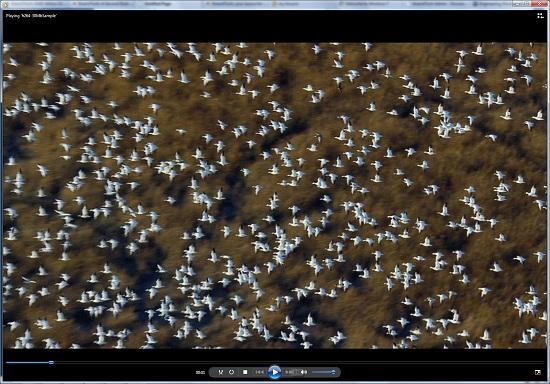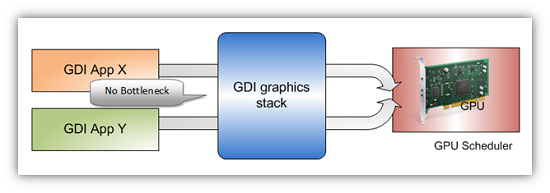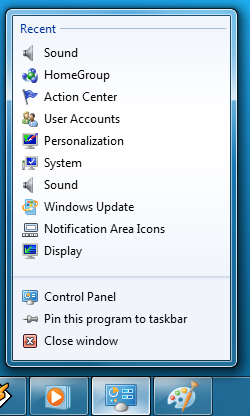Windows 7 Performance Guide
by Ryan Smith and Gary Key on October 26, 2009 12:00 AM EST- Posted in
- Systems
Feature Recap
As we have already covered the bulk of Windows 7’s new features in our look at the Windows 7 Release Candidate, we’re not going to spend too much time here. If you want an in-depth look at the new features, please see that article.
Performance
Vista’s performance was something of a quagmire. Even after SP1 fixed its biggest issues, it continued to be rather RAM hungry and poorly suited for low-end computers and newly minted cheap computers with the performance of older low-end computers. Netbooks made this situation particularly problematic for Microsoft, as their limited performance amplified this issue and resulted in netbooks shipping with Windows XP almost exclusively.
For Windows 7, Windows has been put on a diet in order to perform better on those machines. The most noticeable changes here are that Windows 7 eats less RAM and hard drive space out of the box than a comparable version of Vista did. There have also been some underlying tweaks to SuperFetch (it’s less aggressive on startup) and the kernel to improve responsiveness.
Our own experience here is that Microsoft has come through on this, although whether it’s enough is going to depend on just what someone is looking for. We have a few laptops where Vista was an absolute slug while Win7 runs just as well as Windows normally does. For someone looking for Win7 to perfectly replicate XP’s performance however, they’re going to come away disappointed – you’re never going to stuff something like Windows 7 in to the performance characteristics of an 8 year-old OS that forgoes real security and predates wireless networking.
Also while these changes should percolate to higher-end computers, the impact will be marginal at best. Vista had enough going on that it could bog-down low-end hardware, but hardware that as already capable of running Vista well isn’t going to greatly benefit from changes made to squeeze more out of the low-end. We’ll see this in detail later with our benchmarks.
Media
Windows’ media capabilities have been greatly augmented with Windows 7, primarily through the inclusion of decode and encode capabilities for a number of video and audio formats. While Vista included support for MPEG-2/1 and WMV9 video, Win7 has added support for much more contemporary codecs: H.264 and MPEG-4 (A)SP. Audio support has seen the inclusion of support for AAC and AAC+ audio, commonly found as companion audio streams for H.264 video, streaming internet radio, and portable media players.

Windows Media Player playing a 30Mb H.264 clip entirely in software without breaking a sweat
This gives Windows 7 the ability to play just about everything entirely out of the box, forging the need to deal with codec hell. The only notable things missing here are support for BluRay playback (you’ll need separate software), and some media container types (OGG, Matroska, MOV).
Encode support has been added for H.264 video and AAC audio through the Media Foundation Transcode class. This gives Win7 the ability to encode video on the fly for loading media on to portable media players and streaming to other devices (e.g. DLNA). However the use of this feature is quite limited at this time; only a handful of media players support the level of integration with Windows required to use the encoder. iPods need not apply.
Meanwhile Windows Media Center has seen its own improvements on top of the benefits it derives from greater codec support. At a high level this is a general UI touchup. At a low level this includes adding support for ClearQAM cable tuners, and the user-installation of CableCARD tuners.
Graphics
Windows 7 also brings about some additions to graphics capabilities. The headliner here is DirectX 11, whose introduction is being timed with the launch of Windows 7. DX11 is being released on Vista too any day now, so this is by no means an exclusive feature, but given the timing, it’s one of importance. We’ve already seen AMD launching their 5700 series and 5800 series ahead of Windows 7, so that they can have DX11-supporting cards on the shelves for this launch.
Windows 7-specific changes include the addition of WDDM 1.1, which is a minor update to the video driver stack for better memory utilization. This is accomplished by keeping the texture for a window (when using Aero for desktop composition) solely in VRAM instead of keeping a copy in local system memory too. WDDM 1.1 also brings support for heterogeneous display adapters, something Vista took away.
The GDI graphics stack has also been tweaked for performance reasons. Previously only a single application could write to it at once, making GDI writes a bottleneck. The stack has been changed so that now it’s the responsibility of the GPU to schedule multiple writes, rather than having an application blocked. We haven’t been able to find any performance cases where this is of help, however.

Images courtesy Microsoft
Low-Level
While Windows 7 is not the sizable overhaul of Windows that Vista was, it still has a few low-level changes. The biggest change for users is the official support for the TRIM command for SSDs, which will improve SSD write performance without the need for manual refreshes. The kernel’s dispatcher lock has also been rebuilt for better scaling; previously it effective topped out at 32 cores, now it scales to 256 cores. This will be more felt on the server branch, Windows Server 2008 R2.
Windows XP Mode
Primarily targeted at business users, Microsoft has officially added a derivative of their VirtualPC virtualization technology to Windows 7 in the form of Windows XP Mode. Windows XP Mode is a pre-configured Windows XP Pro virtual machine for running applications that just won’t run natively under Win7, allowing businesses to half-step to Windows 7 as part of a longer transition. It comes as a separate download available for Win7 Professional and higher editions, and no, it doesn’t run games.
Interface
The bulk of the changes in Windows 7 are going to be things that you can see, literally. Various interface elements have received drastic overhauls, and at the risk of slighting all of the other groups at Microsoft, more work appears to have been put in here than anywhere else.
Chief among these is the near-total replacement of the taskbar. The new Win7 taskbar is much closer to Mac OS X’s dock in appearance and function. Active applications appear on the taskbar as just large(r) versions of their application icon, and icons can be pinned in place so that they can be launched from the taskbar in the future, not unlike the old Quick Links feature. Undoubtedly, this is going to be the hardest thing for new users to get used to, although it’s certainly not hard to grow accustomed to.

The Control Panel Jump List
Along-side the dock taskbar are jump lists, which are replacing the normal right-click menu for items in the taskbar. Jump lists contain application specific commands, standard window manipulation commands, and recently used files for the application in question. Applications need to be coded to make full use of jump lists.
Also added are a pair of new Aero gestures. Aero Snap causes an application to be maximized when it’s dragged to the very edge of a screen, and returned to normal when dragged away. Aero Shake minimizes all other windows when a window has been shaken. Microsoft’s Rolodex-wannabe Flip3D is still here, much to our chagrin.
Other notable changes include gadgets, which have been liberated from the sidebar in order to reside on the desktop, and the classic Start Menu, which has been terminated entirely in favor of the Vista (and later) Start Menu. Finally, the whole default color scheme of Windows has been redone; pea green is out, blue/grey is in.
UAC
Finally, User Account Control, the fundamental underpinningsof Vista’s enhanced security, has also seen an overhaul. By reducing the integrity of UAC slightly so that by default it auto-elevates signed Microsoft programs, Microsoft hopes to reduce the perceived annoyance of UAC without compromising the actual security. As a result, UAC should be less noticeable, particularly when first setting up a computer. However there are possible security consequences of this, which we’ll get in to later











207 Comments
View All Comments
Genx87 - Wednesday, October 28, 2009 - link
It is Vista with a facelift. If you already have Vista i agree with you. I only have Win7 thanks to my Technet account. Doubt i would pay for the upgrade from Vista.But I still think Win7 is a very kickass OS. I have been impressed. Except for the dumbing down of UAC.
bigpow - Monday, October 26, 2009 - link
If you're just going over the features, and installation of Win7 - why call it performance guide?"Intro to Win7" would be more appropriate.
We expect to see performance related GUIDES, when we saw that title.
Not just some boring and obvious old-recycled presentations the whole internet has already gone through.
So boring!
computerfarmer - Monday, October 26, 2009 - link
Windows 7 was released and the people with AMD systems running RAID setups were in shock, no RAID drivers for windows 7. This is an issue. Today there has been RAID drives posted at the AMD site, with the posting date back dated to the 22nd.I had tried for hours try to get this new OS installed on the 23rd, but none of the available drivers were accepted by Win7. There for I could not install with a RAID setup. After Googling for a bit I realized I was not the only one, this was a far bigger problem.
My initial excitement of enjoying the weekend with the new OS did not take place. It is now monday and I am wondering when I will take another stab at another install attempt.
The link I have found for the AMD RAID driver is
http://game.amd.com/us-en/drivers_catalyst.aspx">http://game.amd.com/us-en/drivers_catalyst.aspx
Why was this issue not covered by any review sit?
Genx87 - Wednesday, October 28, 2009 - link
This is an AMD issue, not a Win7 issue????How is it Microsofts fault AMD dropped the ball with their RAID driver support?
DominionSeraph - Monday, October 26, 2009 - link
"Why was this issue not covered by any review sit?"Because it's not a Windows 7 issue.
computerfarmer - Monday, October 26, 2009 - link
I believe you are half right.If a business runs a raid setup and most do, they can not use this.
If individuals run raid, they can not use this.
If millions of businesses and individuals can not use this. Then what good is an operating system that so many can not use. This is not good business.
The RC version worked with the existing drivers and the RTM version came with out warning that the rules had changed for this OS. The OS has changed, therefor this is an OS issue.
Genx87 - Wednesday, October 28, 2009 - link
How many businesses do you know run RAID on their desktops? I'd like to know myself because in the thousands of workstations I have built over the past years only a handful ever used any form of RAID. And those were RAID 1 and I am convinced the engineers who ordered them only did it to say they have RAID.DominionSeraph - Monday, October 26, 2009 - link
"Certainly someone is going to bite my head off for this, but I don’t think Microsoft should have made such a fundamental change to UAC. More casual users may not have been fond of how Vista or UAC Level 3 handle security, but it was a more secure choice than Level 2."What are you doing complaining about security while running as admin?
UAC is about social engineering. That it acts like a security feature is because if you want to engineer towards the security model with limited accounts, you have to make the administrator account act like one.
The standard access tokens and UAC nags used by the administrator account are not a part of the tiered model's administrator level -- they're there to mimic the experience of a standard user account so programmers will actually program for standard user account access. (and so users will get used to the prompts for elevation that come with operating as a standard user.)
To obsess over a reduction in limited user -type security in the administrator account is to miss the point that that's not even aligned with Microsoft's security philosophy. Their model (along with everbody else) has been tiered privileges, not somehow patching all possible vulnerabilities out of root.
Vista's default UAC was pretty much universally reviled. People wanted fewer nags, meaning less limited-access -like behavior. But you can't have auto-elevation without a reduction in security.
Could Microsoft do a better job securing the hole they opened to god-mode from the administrator account? Yes. Would the amount of effort be insane, judged in light of the fact that an administrator account is supposed to be god mode? Yes.
Should Microsoft rewrite the Win7 kernel so that these apps run in protected space that restricts them to pre-authorized actions and disallows daughter processes just so the lazy and power-mad among us can dismiss the logical security scheme and continue to run as Administrators 24/7? There's always going to be system vulnerability from the administrator account -- that's kinda its purpose. Instead of trying to secure the unsecurable, Microsoft is trying to get people to embrace a better model.
And at least they took out the obvious stupidity, like MSPaint auto-elevating. (You can delete anything [like C:\WINDOWS] from its file manager when elevated.)
And, for the record, I'm one of those lazy and power-mad who run as Admin 24/7. But I'm also on a non-critical machine.
DominionSeraph - Monday, October 26, 2009 - link
http://technet.microsoft.com/en-us/magazine/2009.0...">http://technet.microsoft.com/en-us/maga.../2009.07...ElectricBlue7331 - Monday, October 26, 2009 - link
What's the big deal about out of the box codec support? Is it really that difficult to get a different media player and/or codec pack?